A Modern Medieval Home Companion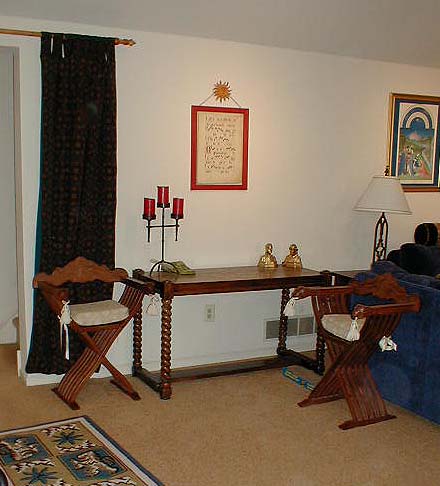
Being a page of suggestions and techniques for bringing Middle Ages
decorative motifs into your own home
New related article: Making fake stained
glass
© 2001 Cynthia Virtue
updated 2004
Introduction:
For those who like stories of King Arthur, or people who are fascinated
with a world long past, there is no reason not to Medievalize our own
homes.
The trouble lies in:
- Finding information about how the medieval folk
decorated their homes (this will mostly be nobility, of course)
- Deciding what you want it to look like
- Making or buying similar
items.
The most famous era for adapting medieval decoration to the
household
was the Gothic
Revival,
which more-or-less peaked during the Victorian era. This period
of
time saw the blossoming of interest in the Middle Ages as a source of
inspiration,
from churches to chairs. It continued with the efforts of the Pre-Raphaelite
Brotherhood (and similar inspired women) of artists, up through the Arts
& Crafts movement which widened into the graceful forms of Art
Nouveau (far less medieval, but still romantic) and the Mission/Craftsman
style of the early part of the 20th century. I mention all of
these different artistic styles because you can find items that are
medieval-ish inside each group. Careful selection will allow you
to build the look you're hoping for.
An excellent example of Gothic Revival is Cardiff
Castle in Wales. (The site is confusing; go to "The Present"
and then "Photo Gallery.") The interior shots are amazing, such
as
the "Winter
Smoking Room." There's also a lot of more modern Gothic
revival (and actual medieval artifacts) at Hearst Castle
-- see the lampshade at the end of this page.
You could contrast these images of Victorian Cardiff with the
Ricardian's
fascinating reconstruction
of Barley Hall. Go through the Virtual Tour: you'll see that
Gothic Revival is
very, very different from Medieval Reality!
Sources of Information:
You can go with the Victorian tomes, such as the authors mentioned in
the
link above about Gothic Revival, with images from medieval manuscripts,
or more modern sources, such as the books Constructing Medieval
Furniture
and Medieval Needlepoint.
You should decide what level of Medievalism you want. There
are
a lot of items sold as "medieval" that would be more accurately
described
as "20th century." Not to say that they are not nice pieces, but
they haven't anything in common with the Middle Ages except for the
name.
One site I found which advertised medieval items had *nothing* similar
to anything that I had ever seen in archeology books or medieval
illustrations.
You may also want to decide if you want some silly medievaloid items,
such
as this cat
castle. Or you may want to go for the Victorian version,
which I'm rather fond of as well.
To some people, medieval decor looks "churchy." This is
because
most surviving examples (or imitations) of medieval architecture are in
gothic style churches. However, like the chalice, which was
initially used
for regular drinking, this is only because the Church continued using
the
older style far longer than the secular world.
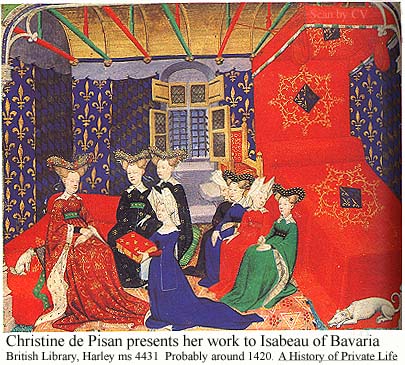
If you wish to be more toward the accurate side of the scale you
should
familiarize yourself with medieval items. Overall accuracy isn't
needed, but a candlestick that looks very medieval will contribute more
to the overall look than one that is only somewhat medieval.
Early
medieval seems to involve a lot of bright painting on walls, but I have
been unable to find good sources to share with you. Here are some
later medieval interiors from contemporary paintings.
These links will open another browser window so you
can read and look at the same time.
- Early
1300s; a musician plays. Note the carved ceiling, carved and
blue-painted walls; the silver grey hanging which conceals them, the
gold-fabric
draped bench with two tall spires (you can see more of the carving next
to the King's leg) and the damask linen tablecloth on which sit golden
dishes.
- Tres
Riches Heures: January, 1412-16. The deep blue hangings with
soldiers and narrative on them, the trestle table covered with white
linen,
the red hanging canopy, fancy plates and glasses. Underfoot is a
blue striped cloth on the dais, and the rest of the floor is covered
with
a braided rug, probably wheat straw or similar.
- Isabeau of Bavaria's bedroom, illustrated on the
right/above.
Note the colored rafters, fine wood ceiling, blue and gold hangings,
red
bed with curtains, smaller red bed (probably a lady in waiting's bed),
the cushions the ladies sit on, one chair next to the window which no
one
is using, the window seat in stone, the beige rug, blue floor
tiles.
You can also see wires or cords which suspend the bed canopy -- look to
the left of the canopy.
- VanEyck:
The Arnolfini marriage portrait, 1434. This is from the
National
Gallery in London; you can click on the picture to enlarge any
area.
Note the bed with its hangings knotted up to keep them out of the way,
the candlestick, mirror, and carved furniture.
- Van
derWeyden: Annunciation, about 1450. Note the bed with
hangings,
the finely carved bench and chest, the shutters on the window,
candlesticks,
ewer, and the tiled floor.
- A
wealthy
man
at dinner; sometime during the 1400s. Note the white
tablecloths,
the woven floor covering, the trestle table legs, the green hangings on
the wall around the fireplace, the curtain over the door. The
tall
side table/cabinet on the left has a fringed edge on its cloth.
Apparently, there is a minor resurgence of interest in medievaloid
furnishings; a large decorating magazine is about to come out with an
issue
on it (Feb-Mar issue of Classic American Home), and an online
magazine has contacted me about some of my material on the
subject.
The market may soon be flooded with medieval items. All to the
good,
I say, but be cautious: a lot of these are likely to be rough and
unfinished.
It's clear from what survives that the best of Medieval art was
elegant,
finished and sophisticated. Caveat Emptor.
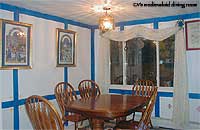
Projects & things I've done
- Painting the Walls In the
early middle
ages, walls were often whitewashed and then painted with bright
designs.
You might not want to do this to your entire house, but a little goes a
long way. This is a guest bathroom that I painted -- very
restrained
compared to medieval versions. Here is the large photo of the
dining room in my new house. By the end of the middle ages,
it
seems that painted ceilings and ornate tapestries were more common than
wall painting. Watch this space for a medieval image, as soon as
I can get my scanner working again.
- Window Treatments -- Buying stained glass is expensive,
and
it is
heavy. Here I have used the product called "Gallery Glass" to put
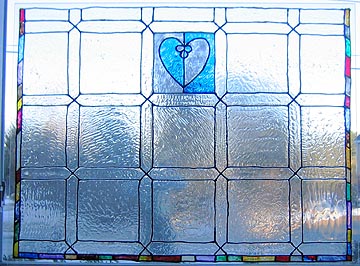 stained-glass designs on plexiglas, which can then be propped up in the
window, or hung, depending on your circumstance. Picture 1: Rabbits;
Picture 2: Unicorn.
Gallery Glass is somewhat like "painting" with colored Elmer's Glue,
but
you get much better results. The curtains are sheets from
Sheridan
sold around 1996 with millefleur patterns on them. New article on how to do this!
stained-glass designs on plexiglas, which can then be propped up in the
window, or hung, depending on your circumstance. Picture 1: Rabbits;
Picture 2: Unicorn.
Gallery Glass is somewhat like "painting" with colored Elmer's Glue,
but
you get much better results. The curtains are sheets from
Sheridan
sold around 1996 with millefleur patterns on them. New article on how to do this!
- Other decorative elements: see the picture
of my living room; elements described below
- Hangings: Give a very medieval 'feel' and are
easy.
These
help with noise insulation as well as being decorative. They are
of a uphostery fabric that I got from an online fabric store. See
one of these on the left side, and in the picture below. These
have
self-fabric tabs, but metal rings would be easier to draw across the
rod,
because these rods aren't very stable, and sometimes they fall down.
- Candlesticks -- wrought iron, not too fancy, and
tall. Flanking
the fireplace.
- Gothic Revival furniture: you can't tell in the
picture,
but there
are some medieval elements in carving on the small green chair between
the hanging and the fireplace. This chair will soon be recovered
in a fabric with a medieval unicorn
pattern. I scored this from
my
mother; it was her grandmother's. (Note: Unicorns are fun, but try and
stay away from the sort that look like a fat white pony with a horn [I
call this the My
Little Pony Unicorn look.] The medieval view of unicorns were
more
like white goats or deer with a horn.)
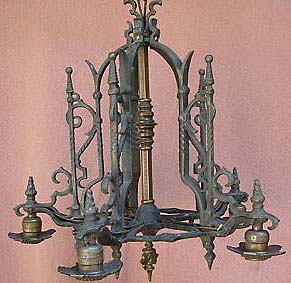
- More revival furniture, this time modern: the X
-shaped
chair in
the left foreground; these can be bought for not a horrible amount
through
some catalogs. These were via the AAFES catalog; I'm searching
for
other sources because you can only use that catalog if you're in the
Service.
You can pay through the nose ($300-1K) for something like it at Design
Toscano. See the picture below for another shot.
- Bench: foreground right: made for me by a friend in
the
medieval
plank style.
- Art: On the left wall are prints from the Tres Riches
Heures; above
the fireplace, a brass rubbing that my Aunt did; over the TV armoire
(craftsman
style) is a griffon and a medievaloid tryptic of the Virgin Mary.
- Couches: If you were lucky, in the middle ages, you
got a
cushion
on your chair or bench. So we went with modern couches that we
liked.
- More Decorative Elements: The one at the top of this page,
to the left of the picture annotated above:
- Rug: heraldic designs. Found at an off-price
store
such as
TJ Maxx, Ross, etc. Looped wool.
- Console table: found at a thrift store. I think
there was
a small
medieval revival in the 1970s, possibly called "Spanish Medieval"; this
is one of the less painful
results.
- Manuscript page: I can't give you a good source for
this
one, as
it was my grandfather's, but there are places that sell manuscript
pages.
Do your homework first. Here is the homework
that
my husband did which mentions this piece, when he replicated it with
another
song.
- Candelabra: From Pier One, 6 years or so ago.
- Electric lights: these I bought 10 years ago through
Bloomingdales.
Their bases are gothic tracery in iron. I haven't seen them
anywhere
recently, but if you look long enough, you probably can find something
that you like.
- Bookend busts of Dante and Beatrice. Also conned
out
of my
mother's stash.
- Items not in the photos of my house:
- Electric Chandelier --
pictured slightly above to the right. I bought it off eBay for
$100, I believe it to have been made around
1930. I think of it as "Wizard
of OZ Gothic Revival."
- Candle Chandelier -- hoop with pierced bits. I
don't own this; I saw it for sale on an antiques auction site.
Someone moderately good with tools could replicate this one.
Possibly not in pink like this example.
- Choosing fabrics: This
is a
page
done for costuming, but it will give you an idea of some
aethestics.
The middle ages were *not* an age of mud-brown. At least, not if
you were well-off.
- In larger suburban areas, there are stores where you can go with
a
bunch
of friends and glaze your own ceramics, which are then fired for
you.
We're not talking life-size ceramic Elvises here, but plates and
trivets
and suchlike. You can use your own medieval motifs on these to
your
heart's content. This is
one
near me, and here's another I used to go to in
California, but there are many different chains that do the same
thing.
- Costuming Your Pets: Ok, I admit this is a bit over the top.
Certainly Aricebo
and Sicorro think so.
- How one Restaurant did things: Burger King
gets
gold stars.
Other Resources & Merchants:
In addition to making your own, medieval items can be bought from many
commercial sources, although a lot of them, such as Design
Toscano, sell "interpretations" of medieval stuff and modern Goth
items,
rather than reproductions of medieval things. You'll be better
off
with museum gift store catalogs, but sometimes the non-museum folks
have
good things. Check out Past
Times,
Art
& Artifact, Boston Museum
of
Fine Art, Art
Institute
of Chicago, etc. There are also people who make furniture to
order, some medieval. Some
of
the catalogs that sell rugs will also sell tapestry reproductions --
shop
around; some are much less expensive, depending on the seller.
Websearches
will turn up a lot of sources. Don't neglect art prints of
tapestries,
which will be much more faithful to the original than a woven fabric
version.
And much cheaper. (Say, $30 instead of $400 for the same size.)
Stop by a fancy fabric store with a "tapestry" section, such as Calico
Corners, or the fabric section of Ethan
Allen. They are unlikey to have "picture" tapestries, but
will
have millefleur, medieval animals, etc. These fabrics can be
ordered
as yard goods and used to put medieval flavor around -- pillows,
throws,
etc, for not too much money; yes, the fabric tends to run about
$25-50/yard,
but you can get four large throw pillows out of just one yard of
fabric.
Even cheap throw pillows (say, at Bed, Bath & Beyond) will cost you
$20 - $40 each; making your own is a bargain, and you could buy the
fabric with a friend and share it. I hope to get some photos of
samples from these
fabric
stores to post here, so that you can print it out and take it to your
favorite
fabric store.
Last, but not least, there are medieval recreationist suppliers that
do more concentration on this era. Not all of those listed
through
the Juried
Merchant's
List are excellent, but there certainly are some good ones
there.
I particularly like Historic
Enterprises, Gaukler
Medieval
Wares, and Billie &
Charlie.
Most of these folks do jewelry and clothing, but sometimes have
household
items. One lady contacted me; she makes tiles in medieval
patterns. Don't ignore trying to find what you want on the Web!
Other Web links: Essay on medieval
folding chairs. Compilation of links about medieval
lighting -- lots of pictures of extant items. Here's the
BBC's own
version of how to have a gothic interior.
 It's
Only My Opinion:
It's
Only My Opinion:
Walls: Some folks like
making the inside of their houses look like
exposed stonework. My belief, based on the images of noble and
middle class houses from the high middle ages, is that this was not a
desired effect -- the desired affect would look much like white-painted
wallboard or plaster! Possibly with half-timbering in it.
So that's
the look that I'm most interested in. You can find webpages about
how to do this, if it's what you want.
What to put on walls:
Medieval folks would have had hangings from floor to ceiling, if they
could afford them; either plain or colored fabric, or full-scale
tapestries if they were very wealthy. I am not so partial to that
look, so I'd rather have prints of medieval tapestries or
illuminations.
About tapestry reproductions:
You can buy small tapestry panels, but I'm also not enamored of
them. Why? Because the effective image quality is terrible.
This may be difficult to explain. Think of a 10-foot-high
medieval tapestry. It's been woven very finely. Then you
take this image and shrink it down to 3 feet high, but the threads
aren't much smaller than the original. You now have a very
"pixilated" version of the original image. That's why I'd rather
have a print of the original than a small-scale fabric copy.
Actually, what I'd really
like to have is a 10-foot-high photo of the tapestry printed onto
canvas, so I could hang it like the real one, but although the set
designers for Harry Potter seem to have found one for the Gryffindor
common room, I don't know where I could find one myself. And it
would probably cost too much money, sigh. So good-quality paper
prints, it
is. (I've written a
new page all about tapestry reproductions, posters, with examples.)
Sometimes you can find prints very cheaply. I have a
piece of christmas wrapping paper that is the Mon Seul Desir tapestry,
which a friend found; I think he got several sheets of it for about $5.
(Look for these in the wrapping & stationery departments of
high-end department stores like Macy's.) Sometimes you'll find
wrapping paper with calligraphy on it; you could put such a thing on a
lampshade to imitate the Hearst Castle use of manuscripts (left).
I also have some brass-rubbings in frames, which would have probably
horrified a medieval person - they're for a grave, for goodness' sake!
But they don't have strong funeral associates for modern folks anymore,
and often have interesting images.
Final notes:
Don't get discouraged. I
collected these things bit by bit over
at
least 10 years. Buy something you see if it suits you, and is
good
quality, and you can manage to afford it. If you really love it,
eat scant for a month if the budget is tight.
Don't worry too much about being totally medieval. The
Victorians made a lot of choices that seem very silly to us today, but
they liked the effect. It's your house; if it makes you happy, go
with it.





 stained-glass designs on plexiglas, which can then be propped up in the
window, or hung, depending on your circumstance. Picture 1: Rabbits;
Picture 2: Unicorn.
Gallery Glass is somewhat like "painting" with colored Elmer's Glue,
but
you get much better results. The curtains are sheets from
Sheridan
sold around 1996 with millefleur patterns on them. New article on how to do this!
stained-glass designs on plexiglas, which can then be propped up in the
window, or hung, depending on your circumstance. Picture 1: Rabbits;
Picture 2: Unicorn.
Gallery Glass is somewhat like "painting" with colored Elmer's Glue,
but
you get much better results. The curtains are sheets from
Sheridan
sold around 1996 with millefleur patterns on them. New article on how to do this! It's
Only My Opinion:
It's
Only My Opinion: